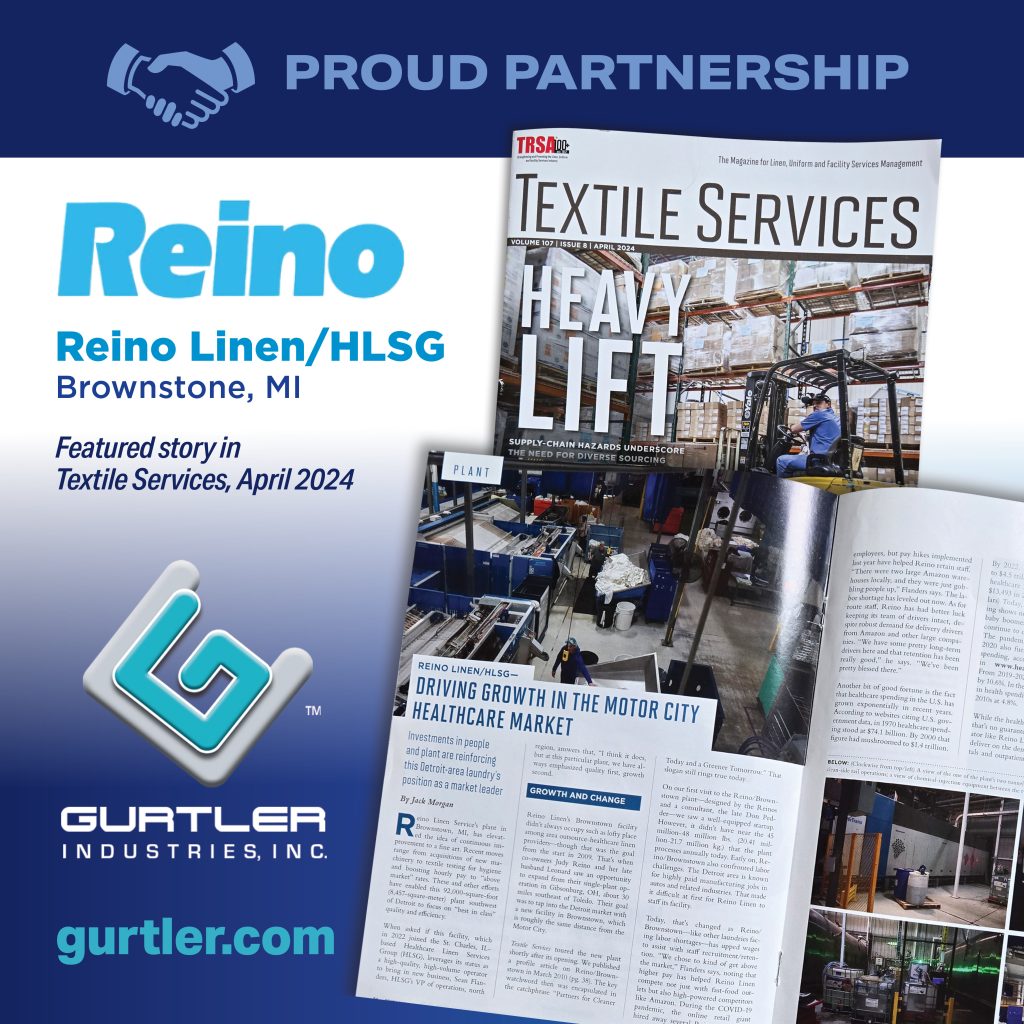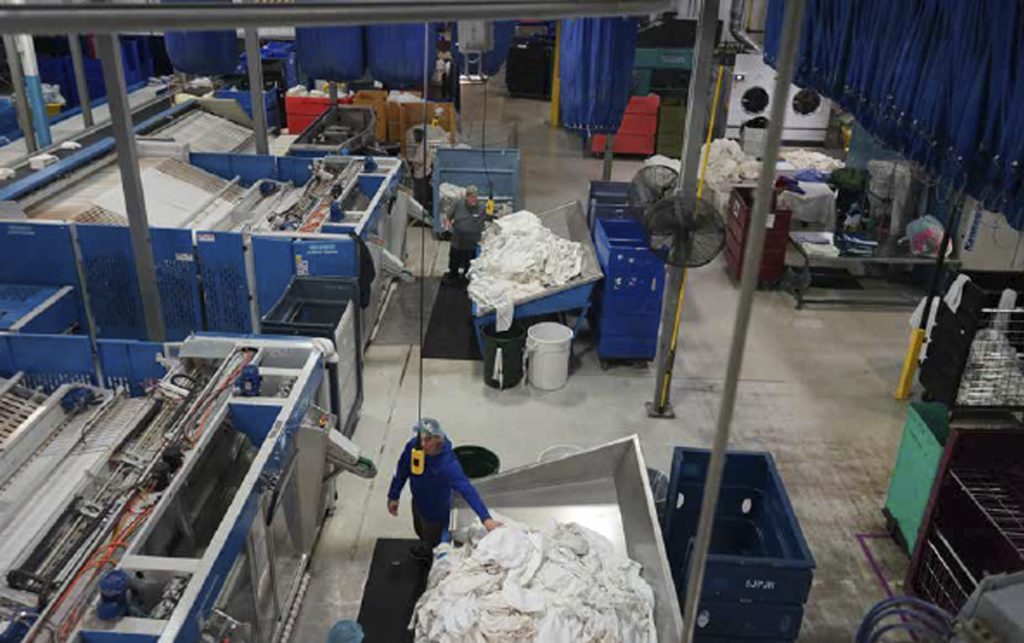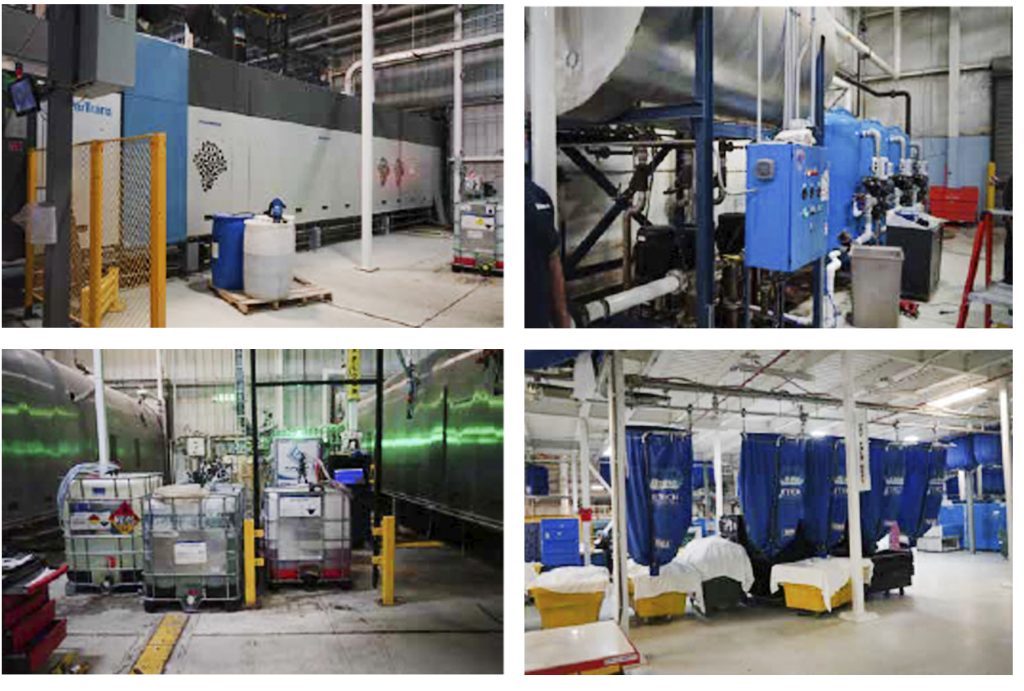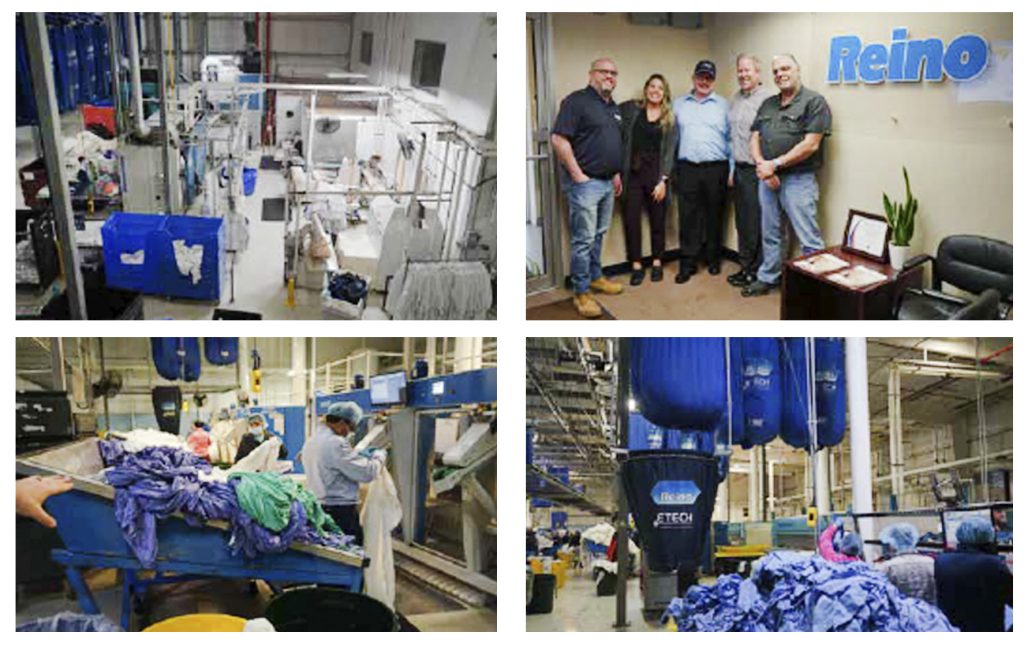April 25th, 2024
Reino Linen an HLSG facility in Brownstown, MI, is a trusted partner/customer of Gurtler Industries and was recently featured in the April issue of TRSA’s publication, Textile Services. From the article: Reino Linen uses the full range of Gurtler laundry specialty chemicals and dispensing systems on their tunnels and washer-extractors. In addition, the plant also has the Gurtler Laundry Software Solutions (GLSS) tracking program. The GLSS system facilitates real-time data collection from production equipment to assist staff in tracking productivity. In the plant, the TRSA team saw several GLSS video screens in the wash aisle displaying production/productivity numbers. The system helps employees and managers meet the plant’s productivity goals, Sean Flanders, HLSG’s VP of operations says. This data is also used in the plant’s route-accounting system from ABS Laundry Business Solutions.
Here is the full article:

Investments in people and plant are reinforcing this Detroit-area laundry’s position as a market leader
By Jack Morgan

Reino Linen Service’s plant in Brownstown, MI, has elevated the idea of continuous improvement to a fine art. Recent moves range from acquisitions of new machinery to textile testing for hygiene and boosting hourly pay to “above market” rates. These and other efforts have enabled this 92,000-square-foot (8,457-square-meter) plant southwest of Detroit to focus on “best in class” quality and efficiency.
When asked if this facility, which in 2022 joined the St. Charles, IL-based Healthcare Linen Services Group (HLSG), leverages its status as a high-quality, high-volume operator to bring in new business, Sean Flanders, HLSG’s VP of operations, north region, answers that, “I think it does, but at this particular plant, we have always emphasized quality first, growth second.
GROWTH AND CHANGE
Reino Linen’s Brownstown facility didn’t always occupy such as lofty place among area outsource-healthcare linen providers—though that was the goal from the start in 2009. That’s when co-owners Judy Reino and her late husband Leonard saw an opportunity to expand from their single-plant operation in Gibsonburg, OH, about 30 miles southeast of Toledo. Their goal was to tap into the Detroit market with a new facility in Brownstown, which is roughly the same distance from the Motor City.
Textile Services toured the new plant shortly after its opening. We published a profile article on Reino/Brownstown in March 2010 (pg. 38). The key watchword then was encapsulated in the catchphrase “Partners for Cleaner Today and a Greener Tomorrow.” That slogan still rings true today.
On our first visit to the Reino/Brownstown plant—designed by the Reinos and a consultant, the late Don Pedder—we saw a well-equipped startup. However, it didn’t have near the 45 million-48 million lbs. (20.41 mil-lion-21.7 million kg.) that the plant processes annually today. Early on, Reino/Brownstown also confronted labor challenges. The Detroit area is known for highly paid manufacturing jobs in autos and related industries. That made it difficult at first for Reino Linen to staff its facility.
Today, that’s changed as Reino/Brownstown—like other laundries facing labor shortages—has upped wages to assist with staff recruitment/retention. “We chose to kind of get above the market,” Flanders says, noting that higher pay has helped Reino Linen compete not just with fast-food outlets but also high-powered competitors like Amazon. During the COVID-19 pandemic, the online retail giant hired away several Reino production employees, but pay hikes implemented last year have helped Reino retain staff. “There were two large Amazon warehouses locally, and they were just gob-bling people up,” Flanders says. The labor shortage has leveled out now. As for route staff, Reino has had better luck keeping its team of drivers intact, despite robust demand for delivery drivers from Amazon and other large companies. “We have some pretty long-term drivers here and that retention has been really good,” he says. “We’ve been pretty blessed there.”
Another bit of good fortune is the fact that healthcare spending in the U.S. has grown exponentially in recent years. According to websites citing U.S. government data, in 1970 healthcare spending stood at $74.1 billion. By 2000 that figure had mushroomed to $1.4 trillion.
By 2022, speeding had jumped again to $4.5 trillion. Spending per capita for healthcare rose from $353 in 1970 to $13,493 in 2022 (in constant 2022 dol-lars). Today, the rate of healthcare spending shows no sign of slowing, as aging baby boomers and population growth continue to drive demand for services. The pandemic that began in March 2020 also fueled a spike in healthcare spending, according to statistics cited in www.healthsystemtracker.org. From 2019-2020 health spending rose by 10.6%. In the next two years, growth in health spending mirrored that of the 2010s at 4.8%.
While the healthcare “pie” is growing, that’s no guarantee for a laundry operator like Reino Linen, unless they can deliver on the demands of client hospitals and outpatient centers. That takes investments, not only in staff, but also in machinery and systems to expand capacity, while improving efficiency.
We learned more about the Reino/Brownstown plant during a walk-through of this two-shift facility.
IN THE PLANT
The Reino/Brownstown plant is located in a suburban industrial park. It opened in a building that was refurbished for use as a healthcare laundry. The owners were lucky to find a structure of sufficient size that had the water, sewer and electrical hookups necessary for a high-volume operation in a location with ready access to area highways. Soiled goods enter at the back of the building through a series of loading docks. Trucks bring in flat-work and garments from eight hospital and four clinic routes. Each cart is barcoded, and each load of soiled items are scanned and weighed so that the laundry can track them—including customer-owned goods (COG) and rental items—throughout the process.
BELOW: (Clockwise from top/left) A view of the one of the plant’s two tunnel washers; water-softening equipment and storage tanks in the mechanical room; clean-side rail operations; a view of chemical-injection equipment between the two tunnels; on the opening page: an overview of two flatwork ironer lines.

The staff process customers’ COG items separately from the rental goods. While COG is common in hospitality plants, healthcare laundries typically lean toward rental. In that sense, The Reino/Brownstown situation is unusual. “We are, to my knowledge, the largest mixed healthcare plant in the country because most of the large plants, including our own Logan’s Healthcare plant (Shelbyville, KY) are all rental. We’re actually kind of 60-40 COG.” Having a large quantity of COG textiles adds to the complexity of ensuring quality and service. “That’s what makes it tricky is there are a lot of changes in a large plant that was set up for rental automation,” Flanders says. When the plant opened, the owners may have thought they could convert COG accounts to rental. These COG customers apparently prefer owning their own textiles.
The next steps in processing are sorting and washing. Employees roll carts to a Kannegiesser/ETECH cart dumper that lifts the cart so that plastic bags filled with soiled items drop onto a table. Employees tear open the bags, remove any waste items and send the goods on a conveyor for sorting. Isolation gowns and other garments are fitted with radio frequency identification (RFID) tags. These are read as the goods pass under a metal hood fitted with an RFID antennae. Both the tags and related equipment are from Positek RFID. The plastic waste from the bags is compressed in a compactor for recycling.
After sorting, the COG and rental goods go into sling carts. When fully loaded and weighed, the slings are raised on a hoist to a storage area in the ceiling. The plant has 16 Kannegiesser ETECH storage rails that can accommodate up to 200 slings of soiled goods. A computer dispatches the slings to one of the two Kannegiesser tunnel washers once space is available. One tunnel dates to the plant’s opening. It has 14, 187 lb. (85 kg.) modules. A second tunnel, added in 2016, has 16 modules of the same size. The tunnels, as well as the plant’s conventional washers, use laundry chemicals from Gurtler Industries Inc. The plant also has the Gurtler Laundry Software Solutions (GLSS) tracking program. The GLSS system facilitates real-time data collection from production equipment to assist staff in tracking productivity. We saw several GLSS video screens in the wash aisle displaying production/productivity numbers. The system helps employees and managers meet the plant’s productivity goals, Flanders says. This data is also used in the plant’s route-accounting system from ABS Laundry Business Solutions. After processing in the tunnel, goods move to the press to remove excess water. Clean, pressed “cakes” then emerge and move via conveyor to any of 32, 187 lb. (85 kg.) dryers.
The plant has a large conventional wash aisle as well. This area is used mainly for small lots and stain-rewash items. Machinery here includes 10 washer/extractors, ranging in size from 30 lbs.-100 lbs. (13.6 kg.-45 kg.) There are also 11 pony dryers, ranging in size from 50 lbs. to 170 lbs. (22.6 kg.-77 kg.). Plant staff have recently undertaken an initiative with stain-rewash efforts in order to reclaim more linen for customers, Flanders says.
As we move toward the clean side of the plant, we stop off in the mechanical room. Here we see two 400 HP boilers, plus an 11,000 gallons-per-day boiler make-up system and boiler feed pumps. There’s also a 1,500-kw generator that can power the plant in case of electricity outages. We see an energy-saving heat exchanger from Kemco Systems Inc., as well. Overall water use is 1.2 gallons per lb.; in the tunnels it’s .8 gallons per lb. Other equipment here includes water-softening tanks, air compressors and a shaker screen for removing lint from wastewater.
Controlling lint from the wash aisle and finishing operations poses a challenge for any linen processor, and Reino/Brownstown is no exception. “These large plants produce lint all day long,” Flanders says. The plant recently acquired several portable fans from Sonic Aire Inc. The fans are placed on long poles that staff can deploy as needed to blow lint down from surfaces, so maintenance staff can sweep it up and remove it. Apparently, the systems are working. We saw very little lint in this plant.
Moving to the finishing area, we notice a walled separation between the clean and soiled areas of the plant. This helps prevent airborne microorganisms from moving to the clean side. The plant also has negative air floor from clean to soil. Ensuring control of microorganisms on textiles is a critical issue for customers, particularly after the COVID-19 pandemic. To that end, Reino/Brownstown coordinates with Gurtler to conduct additional testing on linens by an outside lab. “We have not failed a single one yet,” Flanders says of the tests, which help reassure customers on the laundry’s antimicrobial protocols.
The plant’s finishing area is a hub of activity. Here we see a Kannegiesser ETECH clean-side rail system that moves goods from sling carts filled with textiles from the dryers. A hoist lifts them to a 12-rail storage area that can accommodate up to 200 slings for the next stage of processing. The plant has seven ironer lines, including three Kannegiesser 2-roll machines, three JENSEN 3-role machines and one 6-roll Hypro ironer from American Laundry Machinery Co. The JENSEN and Kannegiesser ironers are each equipped with feeders and folder/stacker equipment. We also see 10 small-piece folders: six from Kannegiesser and four from JENSEN—plus two garment folders from Kannegiesser. RFID tagged gowns, scrubs and other items are counted in bulk in a Positek scanning shed in the packout area.
We stopped briefly at the plant’s operating room (OR) pack area as well. Here, employees assemble OR towels drapes and other goods for use in OR packs. While Flanders says disposable OR goods still predominate at area hospitals, the Reino/Brownstown staff assemble 500-1,000 reusable OR packs a day.
Other equipment in the finishing department includes a Rennco bagger for towels and other small pieces, a Kannegiesser tunnel finisher for garments, a G.A. Braun Inc. folder and a Felins heat tunnel for shrink wrapping plastic-covered stacks of finished textiles. As goods emerge from these systems, employees inspect these goods and place them on carts for movement by truck to the plant’s hospital customers, including 350 outpatient centers affiliated with the hospitals.
In the finishing department and in all areas of the plant, Reino/Brownstown staff take a proactive approach to safety. When we asked Flanders about the safe-ty program, he answers that it’s easier to “show you” because safety at Reino/Brownstown is mostly about awareness. We saw evidence of that commitment in large signs posted around the plant that read “Safety Starts With You.” Others featured photos of company employees with a tagline below, saying “I am Safety.” But the safety effort here goes beyond slogans. Reino/Brownstown has an active employee-driven safety committee that’s overseen by a full-time safety executive at the corporate level. Michelle McNeil, who serves as director of safety for HLSG, regularly visits Reino Linen and the group’s other 19 plants, which process a total of nearly 350 million lbs. (158 million kg.) annually. Plant managers are also active in the program. “We have our Safety Committee members, and our management team attends those meetings,” Flanders says. He adds that employees can call for impromptu meetings anytime they have a safety concern. This hands-on approach—from hourly staff, plus plant and corporate management—enhances the safety program’s effectiveness, Flanders says.
BELOW: Pressing equipment in the finishing area; Reino Linen leadership team: (l/r) Brian Milano, director of transportation; Sami Harrison, HLSG corporate trainer; Matt Doss, Brownstown plan manager; Sean Flanders, HLSG vice president of operations, north region; and Dennis Taucher, Brownstown chief engineer.

CLEAN HANDOFF
Seeing today’s Reino Linen/Brownstown leaves no doubt that the growth that seemed improbable in 2009, has now come to fruition, thus fulfilling the vision of its founders. Now, having completed an ownership transition to HLSG in 2022, what’s next for Reino Linen? Flanders points to additional investments in equipment, such as a pending deal for two new Olma folders from J.P. Equipment Inc., that will help meet a growing demand. Meanwhile, the healthcare textile market post-COVID has shifted in ways that bode well for Reino Linen’s role as a leading launderer for the Detroit-area healthcare market. Specifically. Flanders cites an expansion of textile vendors offering competitively priced quality goods that are helping Reino Linen control costs. “The HLSG Reino/Brownstown Laundry has experienced additional opportunities to purchase linen items as a multitude of smaller linen manufacturers have entered the marketplace, allowing better cost initiatives and savings opportunities,” he says. A third positive development is the prospect of converting more hospitals in this market to reusable isolation gowns. “Reusable gowns are a priority linen item and are being used more frequently after the COVID pandemic,” he says. “There are still some facilities that utilize disposables, but long-term plans call for the discontinuation of said items.” Reusable iso gown use during COVID peaked at 35,000 per day. It’s now at 15,000-20,000 per day, but has “held steady,” Flanders says. Fourth, while inflation has taken its toll on Reino Linen’s bottom line, utility costs recently have stabilized, he says.
While Reino Linen/Brownstown could face new challenges going forward, its bold focus on continuous improvement—from equipment to labor relations—and its commitment to quality, service, hygiene and safety for its customers and nearly 200 employees, bodes well for the future. Bottom line? To us, it looks as though this plant will continue to lead the Detroit-area healthcare textile market for years to come.
JACK MORGAN is senior editor of Textile Services. Contact him at 540.613.5070 or jmorgan@trsa.org.

